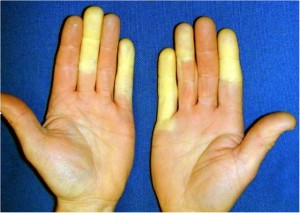
Little is known about the pathogenesis of the secondary form of Raynaud’s disease, vibration-induced white finger disease (VWF), a painful condition affecting the blood vessels and nerves after prolonged use of vibrating machinery. A new study in Clinical Epigenetics by Susanne Voelter-Mahlknecht et al. reports that the Sirt1A2191G single nucleotide polymorphism is a diagnostic marker for VWF.

Sirtuin 1 is a class III histone deacetylase that has been described to regulate the endothelium-dependent vasodilation by targeting eNOS, an intracellular nitric oxide synthase that lines the inside of blood vessels. eNOS regulates the contraction of smooth muscle in vessel walls, which consequently reduces blood flow.
Four genetic polymorphisms (out of 113 that were tested) within the Sirt1 gene were found to actually affect the protein. Of these four genotypes, results demonstrated that the heterogeneous A/G in base pair position 2191 is significantly overrepresented in the VWF patient population when compared with healthy controls – almost a third of the VWF test population.
If the Sirt1A2191G genotype is considered to be a predetermining factor for VWF, it could be used as a biological marker to help identify individuals at risk if exposed to hand-held vibrating machinery in the workplace.
You can read the full article on the website, where you can also sign up for article alerts from the journal. For more information on Clinical Epigenetics, or to submit a manuscript, please visit the journal website or contact the Editorial Office.
Comments